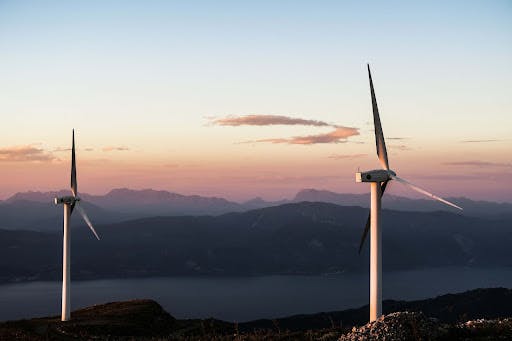How to Research & Evaluate Renewable Energy Investment Opportunities In Europe
6 Mar 2023

Across Europe, there is an ever-increasing need for the development of cheap and clean sources of energy.
Aside from the primary goal of improved environmental conditions, other factors driving this green revolution include increasing prices of extraction and distribution of traditional carbon based fossil fuels, ever-frequent geopolitical flare-ups, and the stark realisation by many governments about the lack of energy security of their respective nations.
This article will provide an overview of the current energy situation in Europe and explores the European Union’s plans to expedite the investment in renewable energy supply both from a regulatory perspective and financial perspective, whilst highlighting some of the things which investors often need to look out for when researching and evaluating investment opportunities across the continent.
We’ll finish off by discussing how energy project marketplace platforms such as PF Nexus are lowering the barrier of entry to private investment.
An Overview of the Current Energy Situation in Europe
Over the last decade, The EU has promoted the development and uptake of renewable energy sources domestically, with recent efforts manifesting in the form of the ‘Fit for 55’ package. A large part of this centres around the notion of increased development of renewable energy sources across its member states, reducing the reliance on carbon-based energy imports.
Vulnerabilities associated with importing energy from neighbouring regions were thrust into the limelight in early 2022, specifically the EU’s reliance on energy imports from neighbouring energy giant Russia.
Mounting geopolitical issues finally boiled over in February 2022 with the war in Ukraine and a subsequent energy crisis resulting as a response by Russia to international sanctions imposed by much of the West. Since then, prices & supply across the energy market have been volatile prompting a ‘cost of living crisis’ and questions about energy security.
March 2022 saw EU leaders agreeing to phase out the region's dependency on Russian energy imports, seeking alternative solutions to fill the void. For context, as of 2020, Russia was responsible for providing over 50% of solid fossil fuels used by Europe as well as 43% of imported natural gas. The EU was responsible for generating 42% of its energy demand domestically, with 40% of energy generated coming from renewable sources.
As part of the EU's Green Deal, the Fit for 55 proposal sets out a series of goals - which are to reduce net greenhouse gases by 55% (based on 1990 levels) whilst aiming to achieve climate neutrality by 2050 - the emphasis is being placed on the development of increased renewable energy projects across Europe, incentives by EU funding and an array of attractive incentives that seek to engage the private markets.
Needless to say, a renewable energy revolution is underway across Europe. Governments are working within the confines of the EU's green energy deal, but this hasn’t halted countries from setting ambitious regional targets to further secure their own energy independence, a case in point is Italy and its ever-evolving renewable energy landscape.
For private investors looking to diversify their portfolios, renewable energy projects are aplenty across the continent. Below we cover from a high-level perspective, what to factor in when researching prospective renewable energy projects, how to best evaluate them and using technology, and how best to identify these projects.

Research & Evaluation of Renewable Energy Projects in Europe
When looking to invest in renewable energy projects, investors should consider the following key areas:
Market trends and growth potential
Europe is undergoing a renewable energy revolution, with plenty of incentives in place to accelerate the pace. Combining the continent's Next Generation EU recovery plan and long-term budget (2021-2027), the European Council has made available €2.018 trillion, with 30% of this focused on the development of renewable energy projects and infrastructure across the continent.
In short, investment opportunities in renewable energy projects will be ripe across Europe over the next decade. Investors will be paying careful attention to member states leading the charge, who are putting plans in place to incentivise their domestic development of renewable energy.
Take a look at our article on renewable energy trends to get a better sense of where the market is looking to invest.
Technology and project feasibility
Technology is at the forefront of development across the renewable energy sector in Europe. The EU has various instruments in place that are contributing to technical development across the EU including: the cohesion policy funds, InvestEU, the Innovation Fund, the Modernisation Fund, Horizon Europe and the LIFE programme. Through Horizon Europe (successor to Horizon 2020), the EU will continue its support & research to reduce the cost of solar energy technologies.
Investors need to ensure that they are assessing the technology used and whether or not the project is feasible. Key factors to consider are: the maturity of the technology used i.e. is it long established or in the early stages of uptake; is the project scalable in that, does it have room to grow; and finally are natural resources abundant in the physical region to allow for continued production of renewable energy
Project structure and financing
A key focus for investors is consideration of the link between the way any project is structured, the underlying risks and the resulting sources of funding available for that risk profile. For example, is it structured within an SPV, or is it corporate-owned? Is revenue secured over a long PPA, or subject to market volatility? Does counterparty risk sit with a private organisation, or are revenue agreements signed by a government? How does inflation affect revenue and costs? Are construction risks mitigated via insurance? By understanding exactly where the risks lay, each can be mitigated or at least minimised, opening up access to cheaper, more risk-averse forms of capital. It’s also important to factor in various appraisals for regulatory risks, technological risks, and market risks.
If you're interested in solar or wind specifically, take a look at our guides in relation to solar power project financing, and wind power project financing to find out more.
Project development stage
The stage of development of the project is also an important consideration. Projects that are in the early stages of development may have higher risks but also potentially greater returns, while projects that are already operational may have lower risks but also lower returns.
There exists a host of existing projects and future planned projects across Europe that institutional capital can invest in. Platforms such as PF Nexus break down the barriers to entry for discovering these projects. We discuss the PF Nexus platform in greater detail in the next section.
Why not take a look at our guide on the solar project development process to find out more.
Terms of the investment
An in-depth understanding is important for a number of reasons including being able to forecast financial returns; understanding the project risks; understanding how the project is structured which in turn advises as to the responsibilities of shareholders and; legal compliance.
Environmental and social impact
The investor may have a mandate which requires certain environmental and social objectives, especially for impact investors and/or investors with funding from ESG-focussed institutional sources. Projects that ensure the buy-in of local populations and projects that promote environmental improvements rather than being at the expense of them will be attractive to these investors.
Any project undertaken should include assessments that factor in the potential impact on local communities, wildlife, and ecosystems, as well as the project's compliance with environmental and social regulations.
A deep level of due diligence is required before any investment, renewable energy investments included. Often the barrier to entry for a lot of potential investors is the lack of information & insights into renewable energy projects across Europe. PF Nexus aims to change this.
PF Nexus
The PF Nexus platform has been created out of a need to more efficiently connect renewable energy investors, developers, lenders, and advisors. As such, the platform is creating a greater level of global visibility and connectivity across renewable energy projects.
Subscribers can access the ecosystem or the renewable energy project marketplace, where they can analyse deal flow and connect with project owners and transaction advisors. The platform allows teams to operate more efficiently by providing a centralised location to discover, research, shortlist, collaborate, and discuss leads and outreach.
Our platform includes projects in utility-scale solar, battery, wind, and other sustainable and renewable infrastructure. With over 4,500 users from 2,500 clean energy companies, the platform has seen rapid growth as countries transition to renewable energy and aim for net-zero emissions.
Source: